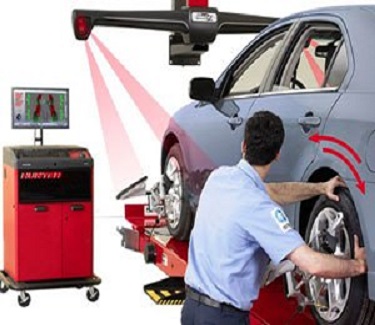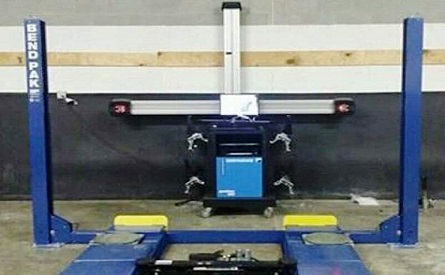The Truth about Front End Alignments

Front end alignments become absolutely necessary in some situations. However, if you didn’t know you needed a front end alignment, until you went to purchase new tires, ask a few questions about why the shop recommends the service.
In this eye-opening article we’ll discover the possible motivation behind the recommendation of an alignment service. In addition, we’ll talk about when this operation benefits you the consumer.
We’ll also talk about the different angles measured during a standard alignment procedure. Finally, we’ll talk about a few ways that you can verify that this often up sold maintenance operation will actually benefit your automobile.
Why Some Shops Recommend Front End Alignments

A full service auto repair center and even a retail tire store that just sells tires needs to invest in a front end alignment machine. We call the latest technology used in measuring angles a laser alignment machine. Equipment featuring this technology costs between $20,000 and $40,000.
Even if the shop opts for the older technology using infrared measuring, this alignment machine still runs in the $10,000 range. It’s the job of the service advisor and mechanic to see that the shop makes a profit on this pricey oversized tool.
With this kind of large investment it’s no surprise that every car that comes in might need to go up on the alignment rack. With the low cost of a basic measurement service in the $30-$50 range the shop often tries to up sell additional front end parts and adjustments.
The tire shop uses the purchase of brand-new tires as an opportunity to get your vehicle up on the rack. These service advisors will often state that it’s for your own good, because they’re trying to protect your investment in rubber. However, it will be your job to determine if the service recommendation is for your own good or the good of the repair center.
What is a Wheel Alignment

The wheel alignment service measures a set of angles on the front and rear wheels. Many modern vehicles allow for minor adjustment of the rear suspension as well as the front. If this describes your automobile the shop recommends the more expensive four wheel alignment.
The four wheel laser alignment cost double what a simple front end alignment costs. When the shop puts you into one of these more expensive services, the first question remains, are my rear wheels adjustable? If the answer is no then there’s no reason to measure those angles and pay more for the service.
Once the vehicle is up on the machine and readings taken, we compare them to factory specifications supplied by the manufacturer. When these front end angles fall within the tolerance of the manufacturer’s specs the vehicle handles properly and we enjoy longer tire life.
Here’s a common situation. The driver pays for front end alignments yet no adjustments become necessary. This equals the best case scenario as long as the shop doesn’t hit you up for additional costs to make unnecessary adjustments. Also note that drivers should always request a printout of their current specifications before the shop makes any adjustments. This way you’ll compare the readout before and after the maintenance service.
Angles Measured with a Front End Alignment Machine

Alignment technicians measure three basic angles during a standard service. Note that this applies to both two wheel and four wheel alignments. The three angles include the toe setting, castor and camber. The camber angle refers to the tilt of the tire when viewing it from the front of the car looking towards the rear.
Mechanics look at the top of the tire and if it’s tilted out, we call this a positive camber reading. If this same tire sticks out more at the bottom and the top leans towards the engine compartment we call this a negative camber reading.
The caster angle in an automotive environment shares a connotation attached to a shopping cart. If you notice the front wheels on the food shopping cart, manufacturers set them back from the center mounting bolt. This allows the front wheels to turn easily, yet returned to the straight ahead position automatically. A standard grocery shopping cart has heavy negative caster. When automobiles have positive caster the steering wheel becomes slow to return to the center position. In extreme situations the car could be hard to steer and keep it going straight.
The toe setting is the last angle to discuss. This is the most common angle adjusted by an auto repair center. This angle measures the distance between the leading and trailing edge of the front tires when the steering wheel stays in the straight position. If you compare them to the way some humans walk a positive toe setting represents someone with a pigeon toe condition. A duck walks with a negative toe setting as the front of his feet point outwards.
How do I know I need a Front End Alignment

As I mentioned in the first sentence of this article, situations remain, when front end alignments become critical to the health and well-being of your automobile and the tires. So the question arises, how do you know the car needs one? To follow we’ll provide some examples of real-life situations that point to an alignment in need of adjustment.
One of the biggest telltale signs that a driver complains about when they actually need this service becomes the position of the steering wheel. If the car travels straight yet the steering wheel point’s off-center to the left or the right, this becomes an indication of a toe setting out of specification.
Another issue common when the settings fall outside of factory specification represents a pulling condition. This happens when the automobile wanders to the left or the right. Drivers with this condition often complain about having to fight to keep the car or truck going straight down the road. Although caster can cause this malfunction often it’s the camber setting at fault. In addition, a tire problem can also cause a pulling condition.
A tire that’s substantially low on air often causes a drift to that side. In other words an automobile will pull to the side with the lowest tire pressure. With that said, when the camber angle measures out of whack, another telltale sign points to the wear pattern on the front tires. A vehicle with negative camber wears the inside treads faster than the center or outside tread. It’s the complete opposite when you have a positive camber reading. In this situation the outside of the tire wears faster.
As you can see, responsibility falls to the driver to make sure front end alignments benefit them and their car. Beware of any tire salesman that says an alignment becomes necessary to protect the warranty of a new tire. If you got 35,000 or 40,000 miles out of the original equipment tires you probably don’t need an alignment. Verify this by looking for even wear across the entire surface that contacts the road.

